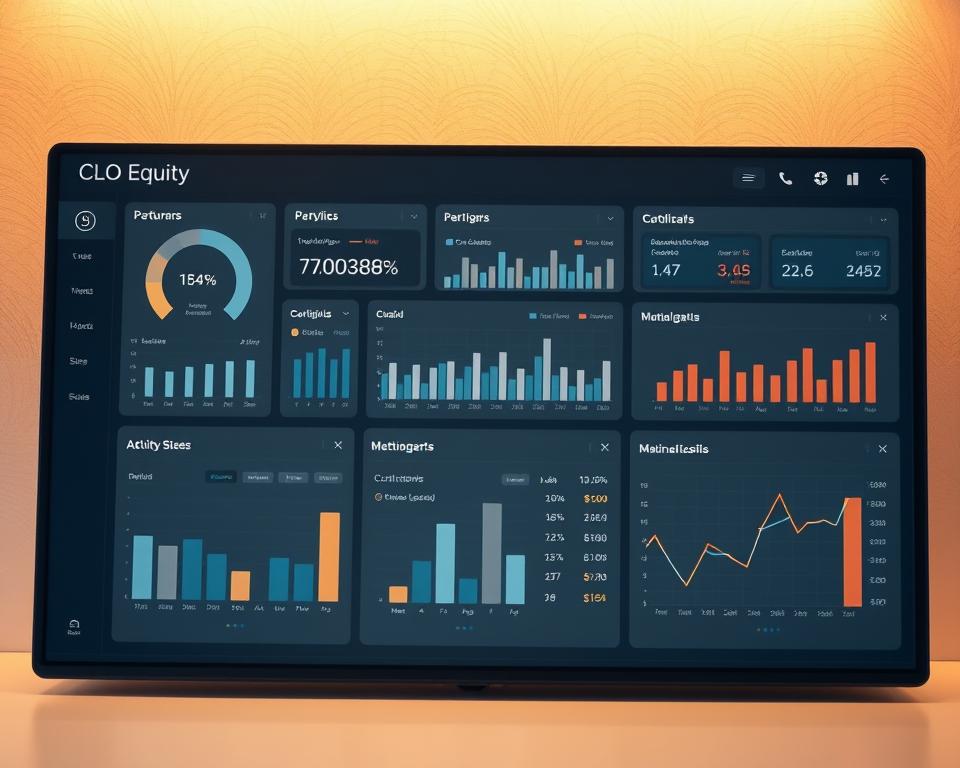Monitor One’s CLO Equity Performance Efficiently
Did you know that CLOs in the U.S. have expanded into an immense $1.1 trillion sector? Such expansion is not merely a matter of figures. It mirrors the economical arena’s complexity and CLO capital’s evolving position for investors such as major retirement funds and family offices. The emergence of advanced stakeholders in CLOs reinforces the necessity of commanding CLO equity performance monitoring.
Investing in CLO equity investments offers multiple benefits, appealing to a diverse array of investors. The possibility of significant gains and consistent cash payouts constitutes CLO funds a beneficial supplement to multifaceted portfolios. This distinctive offering underscores their appeal. Participants are captivated by CLO equity for its elevated return potential, often aiming for mid-teens returns, similar to those pursued in private equity. This allure persists, in spite of shifting interest rates and economic adjustments. CLOs, with their 150 to 200 diverse holdings, offer a level of stability rare in more focused portfolios. I intend to supply you with the critical metrics and perspectives for equity CLO results, assisting in making savvy investment choices.
Comprehending CLOs: A Exhaustive Outline
Collateralized loan obligations (CLOs) are intricate monetary instruments. They bundle multiple leveraged credit, dividing them to investors. Comprehending CLOs is crucial as they supply corporate financing solutions. Over three and a half decades, their evolution has radically transformed investment strategies for institutions. This section provides insight into the CLO market’s history and current dynamics. It highlights crucial trends and features influencing participants.
What exactly is a CLO?
CLOs offer a innovative method for managing borrowed funds. They amalgamate more than 200 corporate loans that are below investment grade but well secured. This strategy minimizes risk while yielding appealing returns. The American CLO market has been thriving, now toppling $1 trillion as of March 2024. It has expanded about 10% per year since 2012. Although growth decelerated to around 6% in 2023, a minor decline to 1% is anticipated in early 2024. Importantly, the top-rated segments, AAA and AA, have maintained default-free status, emphasizing CLOs’ stability.
Growth and Evolution of CLOs over the Years
The trajectory of CLOs is notably marked by their resilience during financial slumps. The financial crisis confirmed this resilience; CLOs sustained a solid credit profile with low default rates, unlike corporate bonds. After dipping to $263 billion post-crisis, the market bounced back impressively. By September 2023, it reached $970 billion. This expansion illustrates their trustworthiness in today’s CLO market environment.
Innovative methods, like CLO ETFs, have driven the market even further. It’s now valued at $15 billion, due to heightened trading activity and liquidity. In the America, a new CLO deal averages around $500 million. In Europe, deals are somewhat smaller, usually €400 million. The lion’s share, 60%-65%, goes to senior tranches. The equity portion make up about 9 to 10%.
Beginning with understanding CLO fundamentals to understanding their progress and contemporary trends, it’s clear they’re vital in financial markets. They notably reconcile risk against return for investors.
The Appeal of CLO Share Investments
Engaging in CLO equity investments offers many benefits, attracting a broad spectrum of participants. The potential for high returns and regular cash distributions render CLO funds a valuable addition to diverse portfolios. This distinctive offering highlights their allure.
Key Benefits for Investors
CLO equity stands out for its potential double-digit returns. Forecasts suggest returns of returns in the low to mid-teens. Regular cash distributions further enhance the appeal of CLO funds, especially for those seeking steady income. Additionally, strong market fundamentals, like low default rates, boost trust in these investments.
Traditionally, CLO share has had lower default rates than conventional debt securities. Even with possible economic strain in certain segments, expected default rates should remain low. In times of recession, high loan spreads can benefit CLO participants. This enables wise credit selection to mitigate possible losses.
CLO Equity vs. Other Asset Classes
Evaluating CLO equity with other asset classes underscores its distinct advantages. It offers higher liquidity than private equity vehicles while maintaining returns. Despite recent spread compression, CLOs still yield more than similarly rated debt, illustrating its allure.
| Asset Type | Gains | Default Rates | Liquidity |
|---|---|---|---|
| CLO Equity | Low to Mid-Digit Returns | Lower than debt instruments | Moderate; not as liquid as Treasuries |
| Private Equity | Varies; typically lower liquidity | Fluctuating with market conditions | Low; often illiquid |
| High-Yield Bonds | Higher than Treasuries | Higher default rates than CLOs | Substantial; superior liquidity |
The demand for CLOs remains strong, indicating a promising outlook for 2024. Competitive financing rates, due to a favorable spread balance, boost this asset. For investors navigating the dynamic market, an understanding of CLO equity can be crucial for efficient strategy formulation.

Tracking CLO Share Performance: Measures and Mechanisms
For those intent on optimizing gains, accurate tracking of CLO capital performance is crucial in the complex financial arena. Efficient employment of CLO performance indicators significantly boosts investment approaches. Understanding key performance indicators (KPIs), such as cash flow distributions, net asset value, and expense ratios is critical. They deliver in-depth perspectives on the operational effectiveness of CLO investments.
Essential KPIs for CLO Capital
CLO equity holders keep a close eye on diverse metrics to efficiently assess outcomes. Notable indicators are:
- Internal Rate of Return (IRR): This metric is vital for assessing long-term profitability.
- Cash-on-Cash Return: Provides perspective on the relation between cash payouts and invested funds.
- Net Asset Value (NAV): Shows the asset market value, essential for assessing CLO worth.
- Cash Flow Distribution Rate: Typically around half of the underlying assets’ cash flows.
- Failure Rates: Historically range between 2% and 3%, with an average 70% recovery rate for defaulted loans.
Utilizing Tracking Tools Effectively
For successful management of CLO share investments, which comprise more than $600 billion globally, effective tracking tools are vital. Firms such as Flat Rock Global supply tailored tools for CLO performance measurement. These tools empower investors to actively monitor their investment collections.
These tools assist in analyzing performance metric trends and setting benchmarks with indices like the J.P. Morgan CLO Index. They also facilitate comparisons with wider indices such as the Bloomberg Bond Aggregate Index and the ICE BofA US Corporate Index.
Making informed decisions to optimize CLO share performance becomes achievable for stakeholders using these key indicators and instruments. This comprehension and proficient use open opportunities for successful CLO management strategies.
Market Dynamics Shaping CLO Share Performance
Examining the CLO equity performance market trends needs a thorough analysis of the economic environment and its influence on investments. Expansion metrics indicate a vigorous market, providing critical insights to investors. By November 2024, U.S. CLO issuances attained $191 billion, a 72% increase compared to the previous year. This underscores an escalating interest in CLOs amidst economic shifts.
Present Market Environment
CLO volume has risen to $465 billion, exceeding the 2021 peak of $438 billion. October 2024 led in new issuances with $59 billion, and November recorded $26 billion, placing second. The market increased by 1% from the start of the year, reaching a total of $1.046 trillion. Moreover, the increase in PCLOs with a $36 billion new issuance, set a new record.
Impact of Interest Rates on CLO Equity
Rising interest rates profoundly influence CLO equity, largely owing to their adjustable-rate characteristic. This makes CLO investments increasingly appealing for those seeking higher returns in a variable market. Forecasts indicate CLO issuances in 2025 could range from $180 billion and $215 billion, propelled by supportive elements. It is essential for CLO stakeholders to observe the default rate, which improved from 3.3% in January 2024 to 3.1% at the end of Q1. This shifting landscape allows for portfolio adjustments amidst current CLO equity market movements.
Active Management Strategies for CLO Equity
Overseeing CLO equity investments demands a proactive strategy. Through strategic market navigation, CLO portfolio managers strive to improve returns and minimize risks. These managers understand the complexities of the market. This understanding profoundly impacts the success of participant investments.
How Managers Drive Performance
CLO equity managers are pivotal in enhancing portfolio results. They keep a close eye on the loan credit quality and pricing. With this information, they exploit market opportunities. Such diligence allows for quick adaptations to market dynamics, maximizing CLO equity distributions. Notable for appealing default rates and low correlation with risk assets like the US corporate 5-year average default rate highlight CLOs’ investment appeal.
CLO Management Risk Mitigation Strategies
CLO investment managers employ diverse methods to guard against financial risks. These approaches are essential for protecting investors during volatile market periods. They concentrate on the gap between asset yields and debt expenses to optimize cash flows. The varying IRRs in CLO equity, with upper quartiles up to 25% and lower quartiles occasionally under 0%, show the importance of these risk mitigation techniques’ value in preserving investment stability amid market fluctuations.
The Role of CLO Index and Benchmarking
Grasping the function of the CLO index is crucial for making informed equity investment choices. It acts as a barometer for CLO equity, echoing market trends and affecting investor approaches. By examining these indices, we gain deep insights into various performance metrics of CLOs. This enables a clear comparison of risk and trends across various asset types.
Understanding CLO Index Performance
The size of the CLO market has expanded to an impressive $1.2 trillion. It now satisfies about 70% of the demand for US corporate loans. Such expansion underscores the need for reliable benchmarks. Here, CLO indices serve a key purpose. They measure a wide range of performance indicators, allowing investors to assess how their investments fare against the market’s broader scope.
Benchmarking Against Other Indices
Comparing CLO performance with other indices sheds light on its positioning. Commonly, CLO equity maintains a roughly 90% debt and 10% equity structure. Concerning safety, AAA tranches record an almost non-existent default rate. This is in direct opposition to the prolonged average default rates seen in U.S. corporations. Hence, CLOs stand out for their appealing returns and exceptional stability within fixed-income assets.
Moreover, CLO performance metrics often point to a spread benefit over traditional bonds, notably in high-yield segments. This translates into higher potential gains for investors and offers advantageous diversification features. CLOs exhibit lower correlation with other high-yield bonds and stocks, enabling smarter CLO market positioning and more insightful investment strategy development.
Challenges in Monitoring CLO Equity Performance
Monitoring CLO equity performance is especially demanding, notably in volatile markets. Stakeholders face challenges due to price volatility that affect risk evaluations and the identification of opportunities. These fluctuations can dramatically affect default risks and buying choices. Thus, deploying effective strategies is essential for sustaining prime CLO performance.
Market Turbulence and Consequences
The bond market forecast suggests that fixed income participants are transitioning to dynamic management techniques. This shift seeks to better accommodate persistent market turbulence, improving returns for fixed income portfolios. Currently, the credit cycle is evolving, not at its zenith, suggesting ongoing opportunities in credit portfolios until 2025. High interest rates further complicate CLO monitoring, increasing the capital burden for CLO equity and emphasizing careful management.
Understanding Default Risks in CLO Investments
One must comprehend the default risks in CLO assets for proper monitoring. Studies show that during economic downturns, CLO loan defaults might reach 3%, detrimentally influencing performance. The interaction of higher interest rates with lower returns across various investment strategies adds to the complexity. Remarkably, about 40% of CLO managers are now leveraging advanced analytics and AI to improve their tracking, tackling transparency issues, and improving performance assessments. The intricacy of underlying assets along with continuous regulatory modifications introduce additional challenges in managing CLO equity performance effectively.
Prospective Future for CLO Capital Investments
The landscape of collateralized debt obligations is witnessing a transformation. This evolution indicates a future for CLO share investments marked by promise and complexity. Market trend analyses reveal significant prospects borne from shifts in supply, demand, and interest rates. A significant leap in new issuances in 2024, totaling $199.8 billion signals a robust recovery. This number represents a 72% increase over 2023 and exceeds past records, affirming the importance of CLO equity in investments.
Record-breaking refinancing and reset activities, reaching $309.1 billion in 2024, validate investor confidence in CLOs. This signals optimistic possibilities, especially for those ready to steer through the changing market dynamics.
Potential Opportunities in the Current Landscape
With regulatory modifications like Basel III on the horizon, an estimated $190 billion could enrich the market. These regulatory shifts are designed to enhance the attractiveness of AAA, AA, and single-A CLO tranches, anticipated to trigger a demand surge. CLOs remain a source of enticing total returns, particularly among lower-rated categories. This demonstrates their remarkable performance and associated risk-adjusted benefits.
Forecasted Developments and Shifts to Monitor
Multiple predicted changes in CLO investment merit consideration. The potential for narrower spreads and improved liquidity looms, influencing investment approaches. The historical resilience against defaults positions CLO equity as a relatively secure investment in volatile markets. With robust issuance anticipated in 2025, astute investors prepared to adjust their strategies may achieve substantial gains amid changing conditions. It’s crucial for investors to keep an eye out for opportunities in secondary equity positions for appealing cash-on-cash returns.
To Conclude
To sum up, effectively tracking CLO equity performance is crucial for investors entering this distinct asset class. Given that the present CLO market valuation surpasses $1.1 trillion, with CLO equity making up about $100 billion, it’s apparent. Such investments provide significant strategic benefits.
The role of active management in enhancing CLO performance during key reinvestment periods cannot be emphasized enough. Given the CLO market’s fluctuations—including interest rates, market conditions, and deal timings, it’s imperative for investors to stay informed and proactive. This method guarantees the flexibility to adjust strategies, thereby maximizing CLO potential.
For those informed investors, engaging with CLO equity reveals notable professional prospects. The blend of diversification perks with substantial return prospects showcases CLO equity as a vital part of diversified portfolios. Looking ahead, keeping pace with market trends and engaging actively in the CLO sphere promises substantial rewards. This underscores the value of a meticulous CLO investment strategy.
Common Inquiries
How would you define a CLO?
Collateralized loan obligations (CLOs) merge multiple leveraged loans, which are then divided and marketed to investors, thereby providing a unique avenue for engaging in corporate finance.
What are the primary advantages of CLO equity investments?
Investing in CLO equity provides significant advantages, including the potential for high yields and consistent distributions. Furthermore, they tend to have low correlation with other asset classes and allow for performance enhancements via adept management.
How can one monitor CLO equity performance?
Monitoring CLO equity involves concentrating on essential performance indicators such as cash flow distributions, net asset value, and expense ratios, with the aid of tracking tools provided by firms like Flat Rock Global.
What current market trends affect CLO equity performance?
Market trends, notably interest rate shifts and economic dynamics, greatly impact CLO equity outcomes. CLO investments can yield higher income as interest rates rise, given their floating-rate nature.
What methods do CLO managers use to improve equity returns?
CLO managers boost returns through effective trading and risk management. They hone in on the credit quality and pricing of loans. Adapting to market changes is also crucial.
How do CLO indices contribute to performance evaluation?
Acting as key performance benchmarks, CLO indices enable investors to compare CLO equity outcomes with overall market performance, enhancing insights into risk and reward.
What challenges might investors face when monitoring CLO equity performance?
Navigating market volatility poses challenges for investors. It influences the assessment of default risks and the timing for purchasing opportunities. Thus, investors must continuously scrutinize the underlying loans.
What does the future outlook for CLO equity investments look like?
The future for CLO equity investments looks bright. The evolving market landscape and potential shifts in interest rates promise opportunities for investors to refine their strategies.

